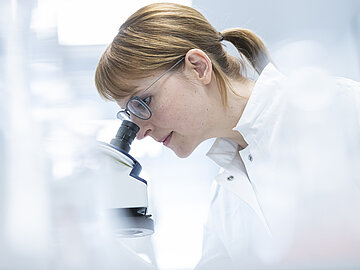
- Material Development
- Interview
- Reading time: 3 min
“Medical-grade plastics”: A term needs clarification.
The term “medical-grade plastics” has been defined differently to date, but is now to be standardized. That was the topic at the 9th VDI Three Nations Conference “Plastics in Medical Engineering” organized by the Association of German Engineers (VDI) in April 2018. The focus of the event was on drafting a new guideline on standardization of the term.
An interview with Dr. Katharina Neumann
Regulations defined in Germany often gain relevance internationally. So that is reason enough to look at the planned regulation in more detail. Dr. Katharina Neumann, Head of the Materials Chemistry department at RAUMEDIC, also took part in the conference. She gives answers to key questions in an interview with us.
Dr. Neumann, what exactly are “medical-grade plastics”?
Medical-grade plastics refer to plastics used to make medical products, products for in vitro diagnostics and primary packaging for pharmaceuticals.
Why is it necessary to discuss the term in the first place?
The requirements for materials that can be used for medical devices are basically defined in national and international regulations such as EU Regulation 2017/745 (MDR) or ISO 10993. In principle, manufacturers of medical products can therefore use any polymeric material provided it meets those requirements. However, things get problematic when we speak of “medical-grade” qualities, since there’s no hard and fast definition for the term. The VDI has now set itself the task of establishing a clear and binding definition.
What are the advantages of standardizing the term?
The new guideline contains specific recommendations for improving safety in application, process and supply security involving the use of plastics for medical products and pharmaceuticals. A clear definition of the term would enable better selection of materials for making medical devices. And that means great advantages, especially for product development.
What requirements will medical-grade plastics have to meet in the future?
The watchword is consistency. Consistency as regards formulation, components and the manufacturing process. That also imposes duties on the manufacturer, for example the need to prove it uses a consistent formulation.
Consequently, manufacturers are also required to establish a change management system as part of a certified quality management system. That means the customer has to be notified if the product’s qualities are impacted by a change in formulation.
Apart from that, the guideline contains many further recommendations on subjects such as delivery reliability, packaging, storage and logistics. Finally, quality agreements between the customer and supplier are also a very important aspect.
How well do you think your own company is prepared for the new guideline?
Some brief background information: RAUMEDIC has tackled the issue of “medical-grade plastics” for many years. That’s also the reason why we’re making an active contribution at the VDI and want to establish a feasible, helpful guideline for everyone together with the other parties involved.
We’re already geared to complying with the requirements documented in the guideline as regards the materials we process. For instance, we believe proof of biocompatibility in accordance with European or U.S. regulations to be a vital factor. That’s because such proof underscores that the materials in question are suitable for use in medical technology.
RAUMEDIC also practices the guideline as regards the procurement and consistency of polymeric materials. We’ve also established technical supply agreements, quality agreements and supplier qualification. So we already have the wherewithals.
What happens with the guideline now?
The parties involved, including the manufacturers of materials and medical devices, have the opportunity until the end of September 2018 to lodge objections to the draft. We’re also examining all aspects of the guideline again very closely. That means we’ll conduct an intensive dialogue with some specialist departments at RAUMEDIC in the coming weeks and months. The VDI then plans to adopt the white paper, i.e. the final version, toward the end of the year.

Dr. Katharina Neuman
Dr. Katharina Neumann deals with questions relating to polymeric materials, additives and compounds. She and her team ensure that the materials used at RAUMEDIC meet the customer’s specific requirements for making medical and pharmaceutical products.